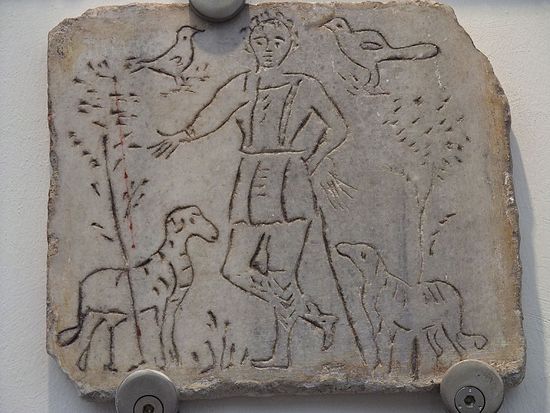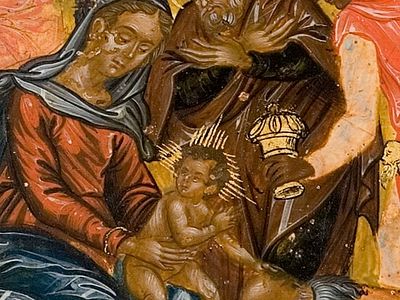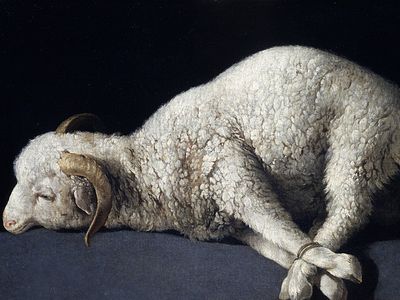Source: Pastoral Ponderings
December 28, 2015
It is a unique feature of St. John’s Gospel that it explicitly introduces the sacrifice of Christ in the preaching of John the Baptist. When Jesus first appears, the Baptist proclaims, “See! The Lamb of God, He that takes away the sin of the world!” (John 1:29)
John had earlier declared his expectation of someone “who comes after me [but] is preferred before me, for He was before me” (1:15). It was foretold, in fact, that on such a one John would see “the Spirit descending from heaven like a dove and remaining upon Him” (1:32). Then, when Jesus appears, John recognizes Him by this sign: “I have seen and testified that this is the Son of God” (1:34).
The occasion of this disclosure was certainly our Lord’s baptism, when, according to the Synoptic Gospels, the Holy Spirit came upon Jesus, while the voice from heaven declared Him to be God’s “Son” (Mt 3:16-17; Mk 1:10-11; Lk 3:22). This is the setting in which the Baptist calls Jesus the Lamb of God who takes away the sin of the world.
The metaphor John uses in this identification—God’s Lamb—combines the evocation of three Biblical images. We may take them in order.
First, inasmuch as this Lamb of God is said to take away “sin,” John’s reference here certainly signifies the Old Testament’s “sin offering,” chatta’ah. The purpose of this sacrifice was to heal and repair the spiritual state—the inner self, the nephesh—of the offender. The “sin” (chet’) in the context of this sacrifice was not so much the act of the sinner as the moral, cultic, and/or spiritual impairment—even the ritual contagion—that resulted from his moral, physical or social failing. The chatta’ah did not attempt to satisfy a divine claim but to rectify, cleanse, and consecrate the human being.
It is significant, therefore, that the Lamb of God is said to take away the “sin” of the world, not its “sins.” John has in mind the world’s fallen state, not men’s individual failings.
Whereas a bullock was the prescribed victim in the Old Testament chatta’ah, Jesus is identified as “the Lamb who takes away the sin of the world.” John did not invent this change in the image. It came from another biblical source, which we will consider now.
Second, in declaring Jesus to be the “Lamb,” John certainly has in mind the description of God’s Suffering Servant in the Book of Isaiah: “He was led as a lamb to the slaughter” (Isaiah 53:7). John elsewhere identifies Jesus as this Suffering Servant, declaring that the Father “did not send His Son into the world to condemn the world, but that the world through Him might be saved” (John 3:17).
Thus, when John says that the Son of Man “must be lifted up” (hypsothenai dei) (3:14; cf. 8:28; 12:32), he is invoking Isaiah’s prophecy that the Lord’s Servant “will be lifted up” (hypsothesetai, Isaiah 52:13 LXX).
It is instructive to observe that in Isaiah 53:4-7, where the Servant is likened to the sin offering, the immolated victim is identified as a lamb, not—as in the Torah—a bullock. This Isaian text is the lens through which John and the other New Testament authors read the Torah (Exodus 29, Leviticus 4; Numbers 28), when they treat the sacrifice of Jesus as a sin offering.
Third, John the Baptist’s reference to Jesus as “the Lamb of God” also evokes the image of the Passover lamb. Although the sacrifice of the Old Testament’s lambs was not a sin offering, it did symbolize Israel’s redemption from the idolatrous bondage of Egypt; the Passover offering was, in fact, the unique sacrifice of deliverance.
The prescriptions governing this sacrifice, which best expressed, arguably, the substance of the Hebrew faith, were given to Israel before the people’s arrival at Sinai. Indeed, they were given before the people left Egypt! (Exodus 12:43-13:16)
The theological significance of this particular sacrifice caused the Christians to interpret the Passover lamb as a type or figure of Christ, who was slain to deliver the human race from demonic bondage. For this reason John the Evangelist, in explaining why the soldiers did not break the legs of the crucified Jesus, cites a verse originally pertinent to the lambs immolated at Passover: “Not a bone of him shall be broken” (John 19:37). John is careful to identify the occasion when this true Paschal Lamb was prepared for sacrifice: “Now it was the Preparation Day of the Passover” (19:14).




